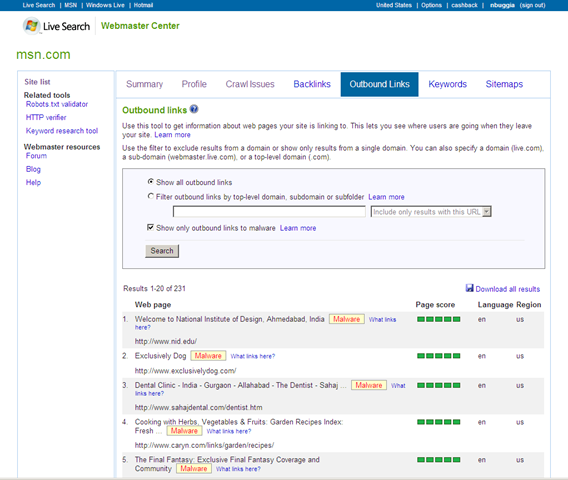Microsoft's Live launches malware detection service for webmasters

"As a site owner, having malware on your site, or even just linking to other sites whose pages contain malware, can harm your customers. At a minimum, this may prevent your customers from being able to access the content on your site from search results pages. With the updated Crawl Issues tool in Webmaster Center, you will be able to :
- Determine whether any malware has been detected on any of your webpages - Download offline-accessible reports detailing which webpages on your website are affected by the detected malware - Determine whether any malware has been detected on any of your outbound links - Download offline-accessible reports detailing which webpages on your website contain links to external pages containing detected malware"
Let's take the feature for a ride. Live Search's Webmaster tool correctly identified that Dental Clinic - India - Gurgaon - Allahabad has been embedded with malware (sahajdental .com/dentist.htm) where once deobfuscated the javascript obfuscation attempts to load sahajdental.com/a37f88e1b18c1a96 .axa3.cn and adwords.google.com.upload.main.update .kliauj.cn, where despite that the main indexes are returning "Account suspended" notices, the malware campaigns within the sites are still active. Google's Safe Browsing diagnostic and Yahoo's SearchScan didn't picked it up, which is a "good" sign in the sense that competition between these free services ultimately serves the webmaster and the average Internet user.
However, Microsoft's web properties remain heavily abused by malicious attackers directly breaking Microsoft's CAPTCHA -- again again and again -- or outsourcing the bogus account registration process so efficiently that hundreds of thousands of bogus Live spaces act as infection vectors and redirectors to malware serving sites. The most recent example was the systematic syndication of popular Google Trends keywords, where the syndicated keywords (download a complete list of the Windows Live Spaces participating) were automatically appearing at Windows Live Spaces and redirecting to fake codecs (Zlob malware variants).
In short - the best benchmark for its actual applicability on a large scale would be its integrating within Live Search, next to running it internally across all of Microsoft's web properties, Live Spaces in particular.